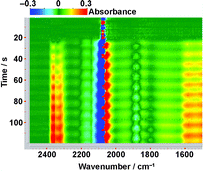A microwave-heated infrared reaction cell for the in situ study of heterogeneous catalysts
Abstract
A transmission infrared microreactor cell which holds a pressed disc in a controlled atmosphere and allows microwave and conventional heating up to 423 K is demonstrated using the oxidation of carbon monoxide over the standard


 Please wait while we load your content...
Please wait while we load your content...